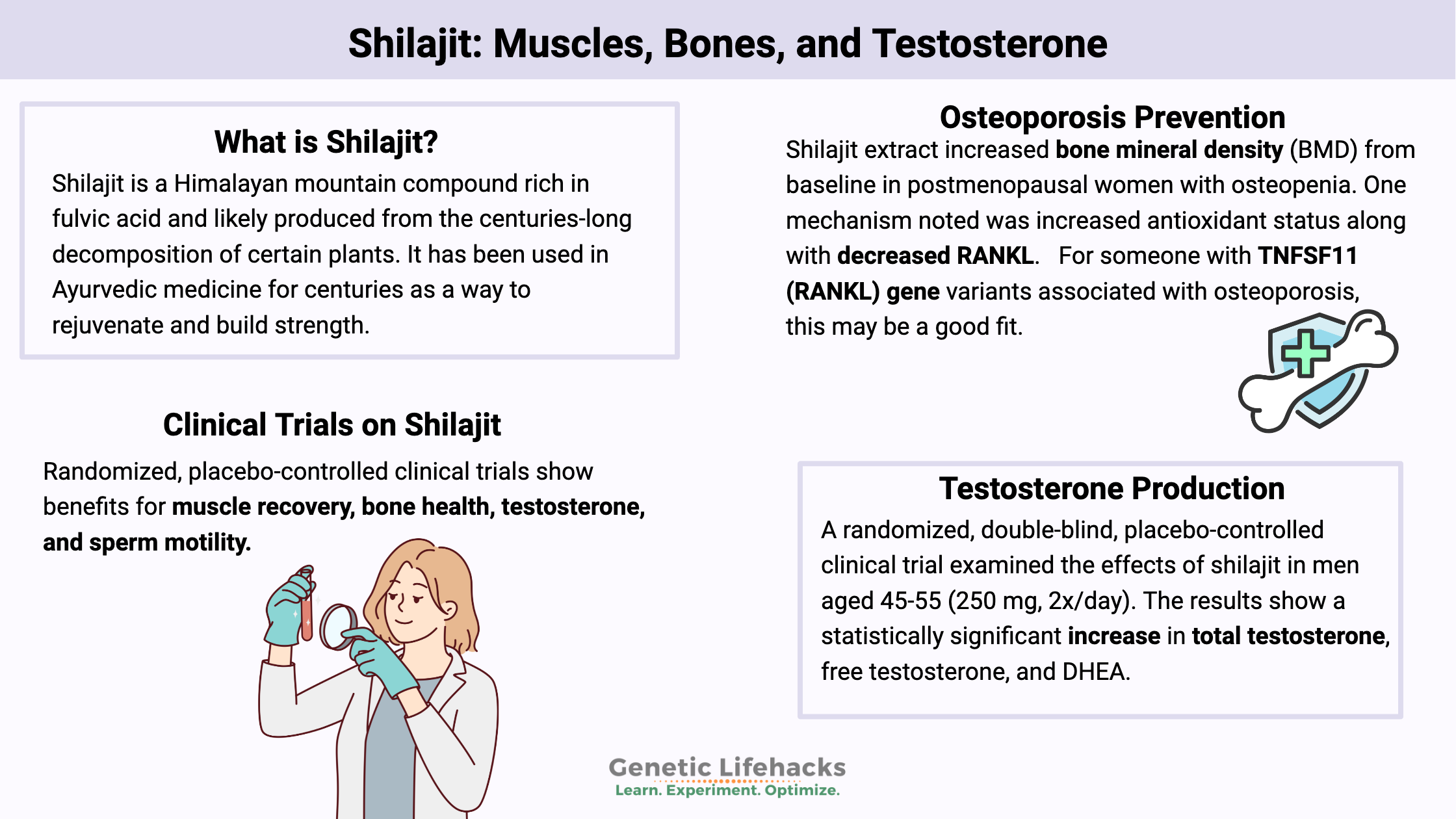Key takeaways:
~ Shilajit contains fulvic acid, metabolites, and minerals
~ Used for centuries, clinical trials show it has positive benefits for osteoporosis, testosterone, male infertility, and muscle recovery.
~ Animal studies suggest that shilajit is neuroprotective, antiviral, and reduces gut inflammation.
What is shilajit and what does it do?
In a nutshell, shilajit is a Himalayan mountain compound rich in fulvic acid and likely produced from the centuries-long decomposition of certain plants. It has been used in Ayurvedic medicine for centuries as a way to rejuvenate and build strength. It is also referred to as Mumie.[ref]
Part of the composition of shilajit is fulvic acid, which is formed from microorganisms breaking down plant material over a long period of time. Shilajit also contains dibenzo-a-pyrones (DAPs) [ref]
I want to get my biases out of the way up front here:
I have avoided writing about shilajit or fulvic acid because, well… it comes across as eating overpriced dirt. The rave reviews of Shilajit on social media seem too good to be true, and I just assumed the hype was from people selling dirt. However, quite a bit of research shows there may actually be something to it… I’ll present the research here; you can make up your own mind on the subject.
Safety first: Is Shilajit safe?
The clinical trials, hundreds of years of use, and animal safety research studies all say that it is safe.[ref][ref] However, part of the safety issue is knowing whether the manufacturer is trustworthy and has a solid product. Look for reputable brands or companies that offer third-party testing of their products. One concern is that there could be heavy metals or mycotoxins in the shilajit, so quality is important here.
What is the difference between shilajit and fulvic acid?
Shilajit contains fulvic acid along with other compounds and trace amounts of a number of minerals. Fulvic acid is thought to be a large part of the benefits seen in shilajit, but there may also be benefits to the combination of minerals and metabolites contained in shilajit.
Human studies on Shilajit:
Randomized, placebo-controlled clinical trials show benefits for muscle recovery, bone health, testosterone, and sperm motility.
Extracellular matrix and collagen – muscle and exercise:
Collagen is an essential protein that makes up bones, tendons, ligaments, and muscles. Degradation of collagen is seen in arthritis as well as muscle and tendon injuries. A placebo-controlled clinical trial in healthy, active men using 250 mg/day or 500 mg/day of shilajit showed that at the higher dose, there was an increase in “retention of maximal muscular strength following the fatiguing protocol”. [ref]
Another clinical trial using 250 mg/2x/day showed that genes related to extracellular matrix, collagen, muscle repair, and muscle formation were upregulated with the supplement. The study was conducted in overweight adults for 12 weeks. The first 8 weeks of the study looked at the changes from the supplement alone, and the last 4 weeks looked at exercising along with supplemental shilajit. The results showed the upregulation of muscle-related gene expression during the first 8 weeks (before the onset of exercise) as well as benefits when combined with exercising.[ref]
Several additional clinical trials show that shilajit supplementation upregulates extracellular matrix genes associated with muscle formation, elasticity, and recovery from exercise and training. [ref][ref][ref]
Osteoporosis prevention by increasing BMD:
Shilajit extract increased bone mineral density (BMD) from baseline in postmenopausal women with osteopenia. One mechanism noted was increased antioxidant status along with decreased RANKL. The conclusion of the clinical trial states: “ Daily supplementation with this shilajit extract supports BMD in postmenopausal women with osteopenia in part by attenuating the increased bone turnover, inflammation, and oxidative stress that coincides with estrogen deficiency in this population at increased risk for osteoporosis and bone fractures.” [ref]
Testosterone production in middle-aged men:
A randomized, double-blind, placebo-controlled clinical trial examined the effects of shilajit in men aged 45-55 (250 mg, 2x/day). The results show a statistically significant increase in total testosterone, free testosterone, and DHEA.[ref] These results are supported by other clinical trials as well.[ref]
Sperm count and male infertility:
In a clinical trial of men with low sperm counts, shilajit extract increased total sperm count and sperm motility. The men took 100 mg capsules of processed shilajit twice a day for 90 days. In addition to significant improvements in sperm count, the men had an average increase of 23% in serum testosterone. [ref]
Possible skin benefits:
A study in overweight, middle-aged women showed that oral shilajit supplementation (250 mg/2x/day) increased microperfusion in the skin.[ref]
Animal and cell studies on shilajit:
In addition to human clinical trials, there are hundreds of studies on the effects of shilajit using animals or cell lines. These studies can give us insight into safety, antiviral properties, and the mechanism of action.
Cholinergic pathways:
Animal studies show that shilajit affects cholinergic signaling in certain types of brain cells. The studies also showed that shilajit does not affect GABA, benzodiazepine receptors, or NMDA receptors. [ref]
Neuroprotective role:
A 2023 study in cells showed that shilajit may be protective against tau aggregation.[ref] This may be beneficial for preventing Alzheimer’s disease. Further studies are definitely needed here.
Stomach ulcers:
An animal study showed that shilajit is comparable to omeprazole (Prilosec) in healing gastric lesions caused by aspirin.[ref]
Inflammation:
A study in animals with fatty liver disease showed that shilajit provided protection against inflammation. The study showed that it increased IL-10 (anti-inflammatory) and decreased TNF-alpha.[ref]
Antiviral activity:
One study showed that shilajit has inhibitory activity against herpes simplex 1 and 2, cytomegalovirus, and RSV. It does not have any inhibitory activity for rotavirus or vesicular stomatitis virus.[ref]
Genetic interactions:
Related Articles:

